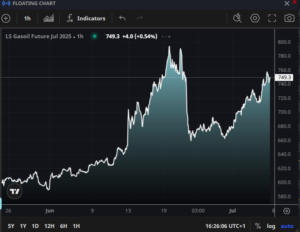Overview: From War Shock to Weather Resilience
The Gasoil market experienced a sharp rally during the recent 12-day conflict involving Iran, driven by fears of a potential closure of the Strait of Hormuz. Despite these concerns, Flux analysts consistently held the view that such a closure was not feasible. This anticipation was confirmed as Iran’s response to U.S. airstrikes was restrained, leading to a rapid market reversal and a return to “business-as-usual” sentiment.
At its peak, the rally in Gasoil futures was significant enough to imply potential increases in diesel pump prices of 10–15p per litre. However, due to the usual two-week lag in retail pricing and the smoothing effect of wholesale moving averages, the price impact at the pump was largely neutralized before being felt.

Source: Flux / flux.live
Since the start of July, Gasoil prices have seen a sustained rebound of nearly $90/mt from recent lows—raising the possibility that underlying weather-related factors, rather than geopolitical risk alone, are now driving strength.
Weather-Related Drivers of Gasoil Strength
Despite broader weakness in crude oil benchmarks, Gasoil prices have remained notably resilient. Several environmental and operational factors are contributing to this trend:
- Extreme Heat Across Europe and Asia
- High ambient temperatures are reducing refinery efficiency, particularly for heavier distillates like Gasoil.
- This thermal inefficiency is leading to lower production volumes.
- Surging Electricity Demand
- Elevated power needs for cooling systems and backup power (especially in industrial sectors) are increasing diesel consumption.
- Low River Levels in Key Transport Routes
- Critically low water levels on the Rhine River in Germany are disrupting barge movements, delaying deliveries and tightening supply.
- Active Hurricane Season in the Gulf of Mexico
- Forecasts indicate above-average storm activity, threatening U.S. refining and shipping operations.
- This risk is further compounded by already scheduled refinery maintenance turnarounds, which typically peak in late summer.
If extreme weather overlaps with these maintenance outages or a major storm, the supply constraints could worsen significantly.

Source: BBC / ERCC / WMO
Market Sentiment: Turning Bullish on Gasoil
- Gasoil is now viewed as better supported relative to other refined products.
- Short positions are being reduced, reflecting expectations of constrained supply.
- Weather premiums are being priced into short-term contracts.
- Strategically, this has renewed interest in:
- Bullish call spreads
- Seasonal calendar spreads
- Crack spread plays
Trade Ideas
Long PPL FP (Pence Per Litre Forward Contracts)
If you’re concerned about rising fuel costs, hedging with Onyx’s pence-per-litre (PPL) contracts may offer protection.
- July may already be too expensive for fresh exposure.
- However, the August contract trades at a $50/mt discount to July, translating to a 1.8p/litre discount on base diesel prices (43.6p vs 45.4p).
- This offers upside if the current strength rolls forward and gets priced into August futures.
Long HVO (Hydrotreated Vegetable Oil)
HVO presents a compelling biofuel play:
- Demand is growing quickly—Germany could see consumption quadruple by 2026.
- HVO has long shelf-life stability, making it suitable for backup power systems like data centres.
- Pricing:
- HVO trades at a premium to Gasoil, around $1350/mt for July.
- August futures are cheaper at $1318, and September at $1311, offering backwardation opportunities.
Contrarian View: Bearish on Deferred Gasoil Cracks
If recent strength proves short-lived, mean reversion could offer a profitable setup.
Short Deferred Gasoil Crack (Sep25 / Oct25)
- Prompt Gasoil strength has lifted the entire crack curve.
- If the supporting factors (heatwaves, storms) subside, deferred cracks could normalise.
- Shorting October Gasoil Swap Crack at $22.73 (with a stop at $24) targets a return to $17.50, offering a 2:1 profit/loss ratio.
- With a standard $1,000 risk:
- Position size = 800mt → $8 per $1 movement.
- Alternatively, smaller clips of 200mt could allow incremental entries with reduced risk.

Source: Flux / flux.live
Conclusion
Short-term strength in Gasoil is likely to persist—at least through the current weather-driven cycle—but we may be approaching a local top. Whether you’re hedging fuel costs, exploring biofuel exposure, or considering a reversion play on deferred cracks, the current market offers a range of opportunities. A flexible strategy that accounts for both upside potential and tactical shorts could be prudent given prevailing uncertainty
CFDs and spread bets are complex instruments and come with a high risk of losing money rapidly due to leverage. The vast majority of retail client accounts lose money when trading in CFDs and spread bets. You should consider whether you understand how CFDs and spread bets work and whether you can afford to take the high risk of losing your money.
